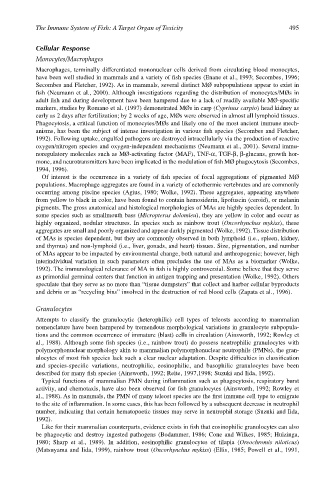Page 515 - The Toxicology of Fishes
P. 515
The Immune System of Fish: A Target Organ of Toxicity 495
Cellular Response
Monocytes/Macrophages
Macrophages, terminally differentiated mononuclear cells derived from circulating blood monocytes,
have been well studied in mammals and a variety of fish species (Enane et al., 1993; Secombes, 1996;
Secombes and Fletcher, 1992). As in mammals, several distinct MØ subpopulations appear to exist in
fish (Neumann et al., 2000). Although investigations regarding the distribution of monocytes/MØs in
adult fish and during development have been hampered due to a lack of readily available MØ-specific
markers, studies by Romano et al. (1997) demonstrated MØs in carp (Cyprinus carpio) head kidney as
early as 2 days after fertilization; by 2 weeks of age, MØs were observed in almost all lymphoid tissues.
Phagocytosis, a critical function of monocytes/MØs and likely one of the most ancient immune mech-
anisms, has been the subject of intense investigation in various fish species (Secombes and Fletcher,
1992). Following uptake, engulfed pathogens are destroyed intracellularly via the production of reactive
oxygen/nitrogen species and oxygen-independent mechanisms (Neumann et al., 2001). Several immu-
noregulatory molecules such as MØ-activating factor (MAF), TNF-α, TGF-β, β-glucans, growth hor-
mone, and neurotransmitters have been implicated in the modulation of fish MØ phagocytosis (Secombes,
1994, 1996).
Of interest is the occurrence in a variety of fish species of focal aggregations of pigmented MØ
populations. Macrophage aggregates are found in a variety of ectothermic vertebrates and are commonly
occurring among piscine species (Agius, 1980; Wolke, 1992). These aggregates, appearing anywhere
from yellow to black in color, have been found to contain hemosiderin, lipofuscin (ceroid), or melanin
pigments. The gross anatomical and histological morphologies of MAs are highly species dependent. In
some species such as smallmouth bass (Micropterus dolomieu), they are yellow in color and occur as
highly organized, nodular structures. In species such as rainbow trout (Oncorhynchus mykiss), these
aggregates are small and poorly organized and appear darkly pigmented (Wolke, 1992). Tissue distribution
of MAs is species dependent, but they are commonly observed in both lymphoid (i.e., spleen, kidney,
and thymus) and non-lymphoid (i.e., liver, gonads, and heart) tissues. Size, pigmentation, and number
of MAs appear to be impacted by environmental change, both natural and anthropogenic; however, high
interindividual variation in such parameters often precludes the use of MAs as a biomarker (Wolke,
1992). The immunological relevance of MA in fish is highly controversial. Some believe that they serve
as primordial germinal centers that function in antigen trapping and presentation (Wolke, 1992). Others
speculate that they serve as no more than “tissue dumpsters” that collect and harbor cellular byproducts
and debris or as “recycling bins” involved in the destruction of red blood cells (Zapata et al., 1996).
Granulocytes
Attempts to classify the granulocytic (heterophilic) cell types of teleosts according to mammalian
nomenclature have been hampered by tremendous morphological variations in granulocyte subpopula-
tions and the common occurrence of immature (blast) cells in circulation (Ainsworth, 1992; Rowley et
al., 1988). Although some fish species (i.e., rainbow trout) do possess neutrophilic granulocytes with
polymorphonuclear morphology akin to mammalian polymorphonuclear neutrophils (PMNs), the gran-
ulocytes of most fish species lack such a clear nuclear adaptation. Despite difficulties in classification
and species-specific variations, neutrophilic, eosinophilic, and basophilic granulocytes have been
described for many fish species (Ainsworth, 1992; Reite, 1997,1998; Suzuki and Iida, 1992).
Typical functions of mammalian PMN during inflammation such as phagocytosis, respiratory burst
activity, and chemotaxis, have also been observed for fish granulocytes (Ainsworth, 1992; Rowley et
al., 1988). As in mammals, the PMN of many teleost species are the first immune cell type to emigrate
to the site of inflammation. In some cases, this has been followed by a subsequent decrease in neutrophil
number, indicating that certain hematopoetic tissues may serve in neutrophil storage (Suzuki and Iida,
1992).
Like for their mammalian counterparts, evidence exists in fish that eosinophilic granulocytes can also
be phagocytic and destroy ingested pathogens (Bodammer, 1986; Cone and Wilkes, 1985; Huizinga,
1980; Sharp et al., 1989). In addition, eosinophilic granulocytes of tilapia (Oreochromis niloticus)
(Matsuyama and Iida, 1999), rainbow trout (Oncorhynchus mykiss) (Ellis, 1985; Powell et al., 1991,

